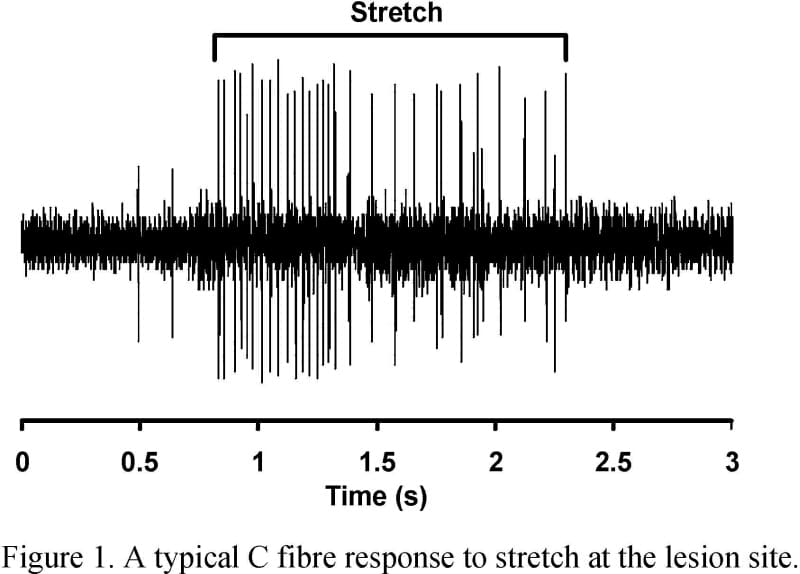Patients with neuropathic pain often have local tenderness over nerve trunks. In addition, pain may occur with limb movements, possibly because nerves stretch during such movements (Hall & Elvey, 1999). Inflammation of a nerve trunk can produce mechanosensitivity to pressure (Eliav, Benoliel, & Tal 2001; Bove et al. 2003). The present study examines the mechanosensitivity of nerve fibres in regions of local inflammation, and specifically looks for responses to nerve stretch. In a preliminary procedure, local neuritis was induced by wrapping oxidised cellulose (Surgicel) saturated in complete Freund’s adjuvant (CFA) around the sciatic or peroneal nerves of Sprague Dawley rats anaesthetised with halothane/N2O. In some cases a small slit was made in the perineurium. In control rats, CFA was replaced with saline. 2-9 days post surgery rats were anaesthetised with urethane (1.5 g/Kg i.p.) and recordings were made from sciatic nerve filaments dissected proximal to the lesion site. Units were isolated using electrical stimulation of either the sural nerve (for sciatic lesions) or the peroneal nerve. Conduction block was measured in peroneal lesioned animals using paired stimulating electrodes positioned proximal and distal to the lesion site. Mechanical sensitivity was assessed at the lesion site using a fine glass probe and by small (<5%) stretch. Experiments were in accord with UK Home Office regulations. Pressure at the lesion site caused responses in 6% (33/545) of C and 9% (21/242) of A fibres. Responses to stretch were seen in 3.0% of C (15/501) (figure 1) and 4.0% of A fibres (8/211), all of which also responded to pressure. In 2 saline treated nerves there were no stretch sensitive units (0/97). A cutaneous or deep receptive field was found for only 1 of 54 units responding to pressure at the lesion site and overall relatively few receptive fields were found for C fibres from inflamed nerves. In 3 of 4 peroneal lesioned rats there was A fibre conduction block at the lesion site (range 22% to 89% blocked). There was no C fibre block. In summary, nerve trunk inflammation can cause small numbers of A and C fibres to become locally sensitive to small nerve stretches. In patients with neuropathic nerve lesions, these stretch sensitive fibres may contribute to the pain felt during large limb movements.
King's College London (2005) J Physiol 565P, C118
Communications: Responses of C and A fibres to small stretches of locally inflamed nerve trunks in anaesthetised rats
Dilley, Andrew ; Lynn, Bruce ;
1. Physiology, University College London, London, United Kingdom.
View other abstracts by:
Where applicable, experiments conform with Society ethical requirements.

